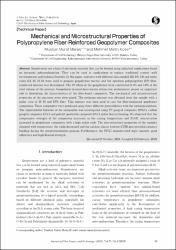| dc.contributor.author | Maraş, Müslüm Murat | |
| dc.contributor.author | Köse, Mehmet Metin | |
| dc.date.accessioned | 2021-07-18T21:21:22Z | |
| dc.date.available | 2021-07-18T21:21:22Z | |
| dc.date.issued | 2019 | en_US |
| dc.identifier.citation | Maras, M. M., & Kose, M. M. (2019). Mechanical and microstructural properties of polypropylene fiber-reinforced geopolymer composites. Journal of Fiber Science and Technology, 75(4), 35-46. | en_US |
| dc.identifier.issn | 0037-9875 | en_US |
| dc.identifier.issn | 2189-7654 | en_US |
| dc.identifier.uri | https://doi.org/10.2115/fiberst.2019-0006 | |
| dc.identifier.uri | https://hdl.handle.net/20.500.12899/300 | |
| dc.description.abstract | Geopolymers are a kind of polymeric material that can be formed using industrial applications based on inorganic polycondensation. They can be used in applications to replace traditional cement with environmental and technical benefits. In this paper, mixtures with different silica moduli (0.8, 0.9,1.0) and molar ratios (12, 14, 16 M) were used to prepare geopolymer mortar, and the optimum polypropylene (PP) fiber-reinforced mixture was determined. The PP fibers in the geopolymer form constituted 0, 0.5 and 1.0% of the total volume of the mixture. Geopolymer (cement-less) matrix interaction performance played an important role in identifying the characteristics of the fiber-based composites. The mechanical and microstructural properties of the mixtures were determined. The optimum mixture was obtained from the sample with a molar ratio of 16 M and 0.5% fiber. This mixture was then used to cast the fiber-reinforced gepolymer composites. These composites were produced using three different geosynthetics with the optimum mixture. The experimental behavior of the composites was investigated using PP geogrid composite (PPGC), carbon geogrid composite (CGC) and polyfelt geotextile composite (PGC) under flexural loading. We observed that the compressive strength of the composites increased as the curing temperature and NaOH concentration increased in geopolymer composites with a high molar ratio. The microstructural properties of the samples changed with temperature: the voids decreased and the calcium silicate hydrate (CSH) gels provided compact bonding during the geopolymerization process. Furthermore, the PPGC demonstrated high viscosity, good adherence and high flexural strength | en_US |
| dc.language.iso | en | en_US |
| dc.publisher | The Society of Fiber Science and Technology | en_US |
| dc.relation.ispartof | Journal of Fiber Science and Technology | en_US |
| dc.rights | info:eu-repo/semantics/openAccess | en_US |
| dc.subject | Geopolymers | en_US |
| dc.subject | Fiber-Reinforced Geopolymer composites | |
| dc.subject.lcc | Building materials. | en_US |
| dc.subject.lcc | Polymers. | en_US |
| dc.subject.lcc | Structural materials. | en_US |
| dc.title | Mechanical and microstructural properties of polypropylene fiber-reinforced geopolymer composites | en_US |
| dc.type | Article | en_US |
| dc.authorid | 0000-0002-6324-207X | en_US |
| dc.department | MTÖ Üniversitesi, Mühendislik ve Doğa Bilimleri Fakültesi, İnşaat Mühendisliği Bölümü | en_US |
| dc.institutionauthor | Maraş, Müslüm Murat | |
| dc.identifier.doi | 10.2115/fiberst.2019-0006 | |
| dc.identifier.volume | 75 | en_US |
| dc.identifier.issue | 5 | en_US |
| dc.identifier.startpage | 35 | en_US |
| dc.identifier.endpage | 46 | en_US |
| dc.relation.publicationcategory | Makale - Uluslararası Hakemli Dergi - Kurum Öğretim Elemanı | en_US |
| dc.identifier.scopus | 2-s2.0-85081579589 | en_US |
| dc.identifier.scopusquality | Q4 | en_US |
| dc.identifier.wos | WOS:000467772000002 | en_US |
| dc.identifier.wosquality | Q3 | en_US |
| dc.indekslendigikaynak | Web of Science | en_US |
| dc.indekslendigikaynak | Scopus | en_US |


















